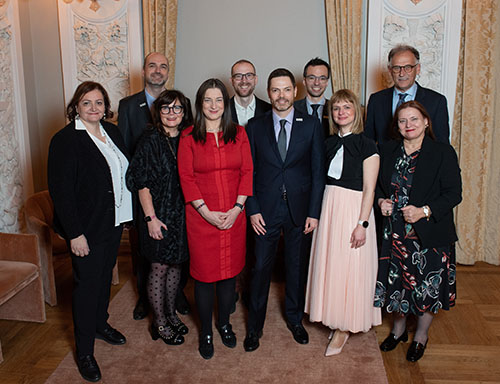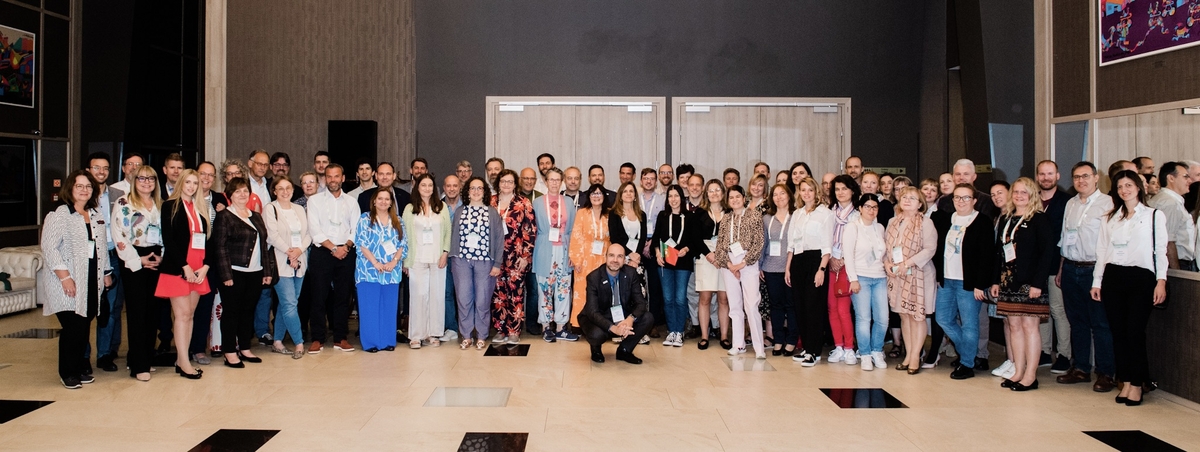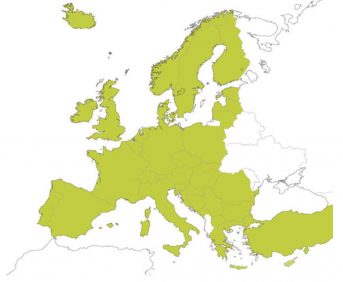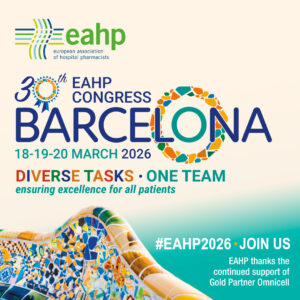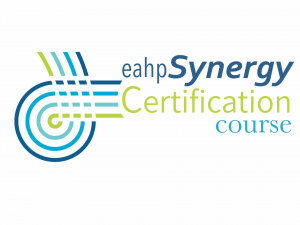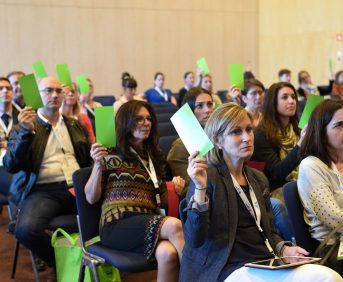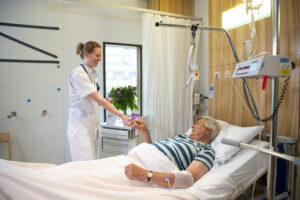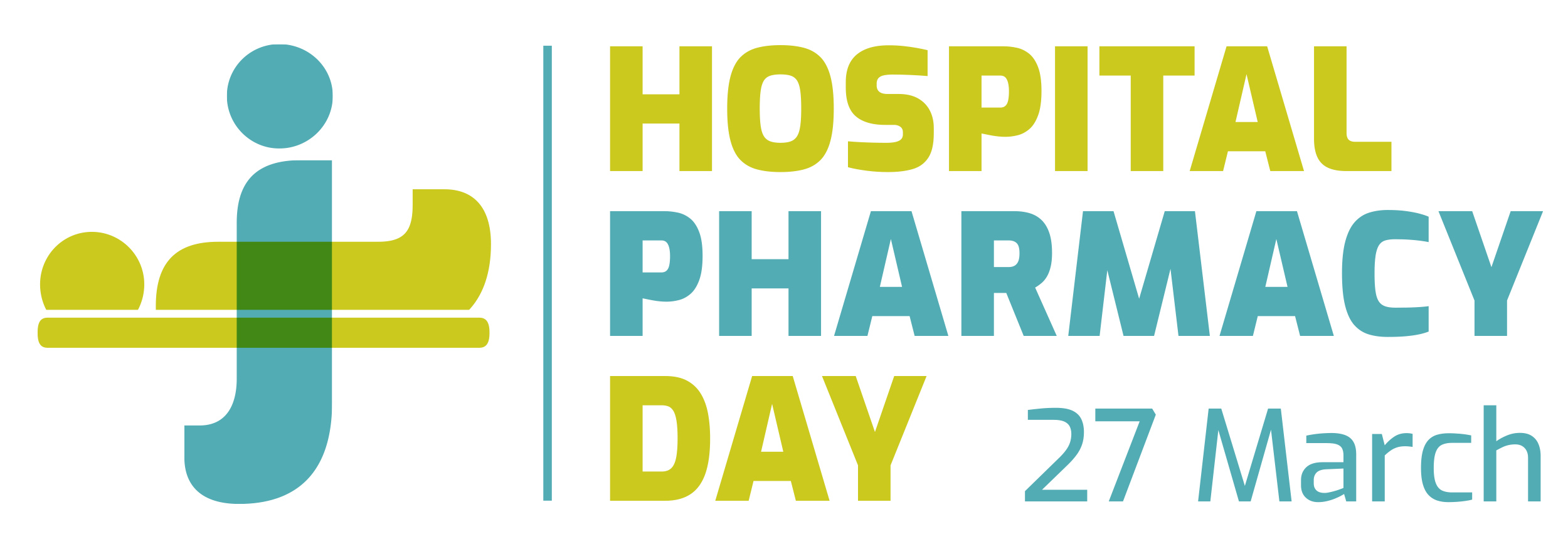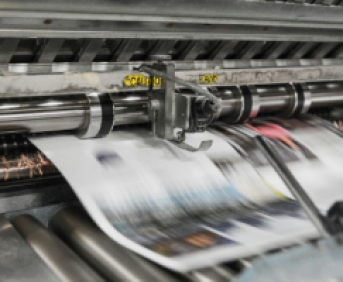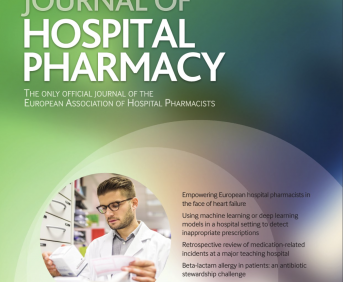THE IMPACT OF A WARD SATELLITE PHARMACY ON CLINICAL PHARMACY SERVICES AND POTENTIAL COST BENEFIET (submitted in 2019)
Pdf

European Statement
Patient Safety and Quality Assurance
Author(s)
Thewodros Leka, iun Grayston, Mashal Kamran, Biljana Markovic
Why was it done?
The Carter report recommended that about 80% of hospital pharmacist time should be spent on the wards to provide clinical pharmacy services. However, in our hospital’s surgical specialty at the time of this report, it was found that only 33% of pharmacist’s time was spent on clinical pharmacy services. This had a negative impact on:
• rate of medication errors and near misses
• supply of critical medicines
• pharmacist participation in productive ward rounds
• timely discharge of patients home
What was done?
The Pharmacy department made a successful business case to the Hospital executives to open a Satellite pharmacy to serve 4 surgical wards. The proposal was to recruit a dedicated clinical pharmacist and Medicines Management Technician, and set-up a dispensing satellite pharmacy.
How was it done?
The business case indicated that if funded, the new satellite pharmacy team would: • improve clinical pharmacy key performance indicators • improve patient safety • deliver a potential cost benefit Funding limitation was an obstacle and we have to convince the board.
What has been achieved?
We achieved 60−90% improvement in the objectives set in the business case as illustrated in Table 1 and 2. The pharmacy team won the annual quality improvement award of 2018. Table 1: Clinical Pharmacy Service improvement Clinical pharmacy services Service rate pre-satellite pharmacy Service rate post satellite pharmacy % of service improvement Medication errors 16/month 6/month 63% Pharmacist interventions 20/month 80/month 75% Pharmacist participation in ward round 6/month 50/month 88% Time to dispense discharge summaries 90 minutes/discharge summary 20 minutes/discharge summary 77% Number of patients counselled 15/month 75/month 80% Pharmacist available in the ward 1.5 hrs/day 7.5 hrs/day 80% Time taken to supply critical medicines 1 hour 5 minutes 91% Table 2: Potential Cost-benefit savings achieved Activities Cost-benefit savings/year (€) Reducing length of stay of patients €17,000 Reducing repeat dispensing €16,000 Effective use of nursing time €11,000 Reducing prescribing errors €103,000 Total Savings €147,000.
What next?
• Weekend working.
• Service improvements can be transferred to acute medical units and downstream medical wards. Reference Carter report.
IMPLEMENTATION OF PATIENT INTERVIEW IN CONNECTION WITH MEDICATION REVIEW IN AN INPATIENT PSYCHIATRIC WARD (submitted in 2019)
Pdf

European Statement
Clinical Pharmacy Services
Author(s)
Majken Nørskov Petersen, Dorthe Bonnerup, Louise Thorsen, Lona Louring Christrup, Sune Puggaard Vogt Straszek, Charlotte Olesen
Why was it done?
Medication review with patient interview provides the opportunity to clarify the patient’s overall drug intake along with identifying the patient’s experienced side effects. Medication review with patient interview we believe gives a more realistic picture of experienced drug related problems (DRP) and potentially DRP. This again makes the medication review more relevant and useful to the doctors.
What was done?
The initiative took place in the Department of Affective Disorders, at Aarhus University Hospital, Denmark. Initially, the medication review was performed by hospital pharmacists without patient interview based only on medical records. We implemented a patient interview to give a more clinically relevant medication review. The interview included a structured questionnaire on typical side effects of antipsychotics.
How was it done?
The cost of a new workflow is always weighed against the outcome. We therefore planned and conducted a pilot study. The cost was measured as the time used for the patient interview and it was 17 minutes on average. We used DRP as the outcome. DRP is an accessible measure for the immediate outcome of a medication review. Sixteen medication reviews without patient interview were conducted and the same 16 patients were interviewed for a second medication review. Patient interview increased the number of identified DRP from 52 to 68. Due to the interview 28 new DRP were identified and 12 DRP found before the interview were withdrawn due to irrelevance.
What has been achieved?
Patient interview has been implemented in one of three inpatient psychiatric wards and in one of four outpatient clinics where the pharmacists conduct medication review. The structured questionnaire has been further developed and now includes common side effects caused by antipsychotics, antidepressants, benzodiazepines and mood stabilizers.
What next?
We still use the pilot study to show how medication review can be more relevant by using patient interview. The hospital pharmacy in Aarhus works on several levels in order to implement medication review, preferably with patient interview.
DEVELOPMENT OF AN INTERNATIONAL EXCHANGE PROGRAMME IN HOSPITAL PHARMACY PRACTICE (submitted in 2019)
European Statement
Education and Research
Author(s)
Agnes Ann Feemster, Nicoletta Zallocco, Carlo Polidori
Why was it done?
Development of pharmacy education on a global scale is an international initiative. Additionally, employers recognise that global experiences positively impact a variety of applicant qualities, including curiosity, willingness to take risks, a non- judgmental attitude, and a broader worldview. The goal of this collaboration is to expose students to the medication distribution system and role of the pharmacist in an international practice setting with an aim of developing a more well-rounded, culturally aware pharmacist.
What was done?
A partnership between the University of Camerino (UNICAM), Camerino, Italy and the University of Maryland School of Pharmacy (UMSOP), Baltimore, Maryland, USA was formed. Under the agreement, the two universities exchange student pharmacists for five-week internships in hospital pharmacy.
How was it done?
A memorandum of understanding was implemented between the two universities in May 2018 with the first UMSOP student visiting in September 2018. A professor from each university co-coordinates the internship. UMSOP students self-fund travel while UNICAM students self-fund and seek university support; funding is a barrier to pursuing the experience. Housing logistics for the students is also challenging. UMSOP students receive academic credit for the experience, requiring that the Italian site meet the advanced practice experience objectives.
What has been achieved?
The programme intended to exchange one-two students annually. After the inaugural student, eight UMSOP students pursued the UNICAM internship, resulting in six student placements at three Italian hospitals. One UNICAM student pursued a cardiology experience at an academic medical centre in Baltimore. UMSOP students perform a preceptor and site evaluation after the internship. 100% of students completed the evaluation with an overall evaluation score of strongly agree that the preceptor and site provided a positive experience. A structured interview with the UNICAM student indicated a greater understanding of clinical pharmacy practice and the role of a pharmacist on an interdisciplinary team, which may be used to further develop hospital pharmacy services in Italy.
What next?
This international exchange demonstrated a high degree of satisfaction among participants. While currently limited to students, this initiative should be considered for practising pharmacists. Sharing of best practices and the interchange of ideas may generate practice enhancements, lead to innovations, and stimulate personal growth.
INTEGRATION OF THE CLINICAL PHARMACIST IN A MULTIDISCIPLINARY TEAM IN A BURNS UNIT
European Statement
Clinical Pharmacy Services
Author(s)
Ángel Guillermo Arévalo Bernabé, Pilar Lalueza Broto, Jordi Serracanta Doménech, Jacinto Caparrós Baena, José Manuel Collado Delfa, Jordi Aguilera Sáez, Romy Rossich Verdés, Pablo Sánchez Sancho, Juan Carlos Juárez Giménez, Maria Queralt Gorgas Torné
Why was it done?
The burns unit of a third-level hospital includes a patient’s great heterogeneity depending on his population group and his clinical condition (extension, degree and depth of his burns, etiological agent of the burns and associated comorbidities), which makes the managing of these patients complex and they need multidisciplinary solutions. In addition, extensive burns provoke physiopatological alterations that involve changes in the pharmacokinetical and the pharmacodynamical modelling of some drugs. The knowledge that the pharmacist has about the changes that take place in vascular dynamics, the clearance and the distribution volume of the drugs, and the degree of union from these to plasmatic proteins, makes his active participation in the care of the burns patient, and in the optimisation of his pharmacotherapeutic plan, very interesting.
What was done?
The integration of the pharmacist into a multidisciplinary group of assistance to the burns patient constituted as the Managing Committee of Cases and was integrated by plastic surgery, intensive medicine, intensive paediatric medicine, preventive medicine, infectious diseases, psychiatry, psychology, social work and infirmary, as well as pharmacy.
How was it done?
A protocol was devised that standardises and systematises the review of the pharmacotherapeutic plan of all patients in the burns unit, including burn critical and paediatric. Also, there is included a model of record and codificate of pharmaceutical interventions. The multidisciplinary group meets weekly and every patient is analysed from all clinical points of view, the pharmacist intervening in relation to the pharmacotherapeutic and nutritional plan.
What has been achieved?
The active integration of the pharmacist has been achieved in the clinical group of assistance to the burns patient. In addition, there has been created a collaborative attitude that has benefited joint projects of investigation. The degree of acceptance of the offers of modification that the pharmacist realises is 90%.
What next?
The following step must be, depending on the obtained results, to establish improvement assistance measures, including the accomplishment of protocols and the development of investigation projects that help to generate knowledge about the use of some drugs in burns patients, such as immunoglobulin or proteolitic enzymes for the extraction of bed sores.
THE PHARMACIST IN THE LUNG CANCER MULTIDISCIPLINARY TEAM
Pdf

European Statement
Clinical Pharmacy Services
Author(s)
Ana Soares, Armando Alcobia
Why was it done?
Several clinical practice guidelines for LC recommend that multidisciplinary teams should be used to plan patients’ treatment. The evolution of thoracic oncology, namely the increasing knowledge of the diverse histologic and molecular phenotypes in non-small cell LC, has been driven to more complex treatment algorithms in recent years. This complexity increases the need for a multidisciplinary approach in therapeutic decision-making, which must be individualised and based on the best information available. The pharmacist’s inclusion in the multidisciplinary team is essential and was formerly proposed by the Pneumology Director to the Hospital Administration Board.
What was done?
A hospital pharmacist is a permanent member of the lung cancer (LC) multidisciplinary team, which has met weekly since January 2016, to plan the management and treatment of LC patients in our hospital. The pharmacist brings updated information about the efficacy and safety of drug treatments, its cost-effectiveness and its availability. The pharmacist improves communication with the Pharmacy and Therapeutic Committee.
How was it done?
The multidisciplinary team meets weekly to discuss the diagnosis and treatment options of LC patients, and includes a dedicated group of professionals: pulmonary oncologists, a thoracic surgeon, a radiation oncologist, a radiologist, a pathologist, a nuclear medicine specialist, a hospital pharmacist, a palliative care physician and an oncology nurse.
What has been achieved?
About 240 cases, corresponding to 200 patients were discussed per year. An average of 110 solicitations to the Pharmacy and Therapeutic Committee were made. The multidisciplinary team grants a systematic approach to diagnosis and therapeutics, in compliance with evidence-based guidelines, improves communication and coordination between professionals and short waiting times for the patient.
What next?
The next step is to systematise real-world data collecting, from the patients treated, to better understanding the effectiveness of treatment options and the real impact of the multidisciplinary team in patient outcome, ideally, extending it onto a national level.
HOW TO HANDLE ACTIVE AND PLACEBO DRUGS FOR A CLINICAL TRIAL IN THE PRODUCTION SYSTEM CATO IN ORDER TO SECURE THE BLIND AND TO ENSURE THE EXACT SAME PREPARATION OF ACTIVE AND PLACEBO PRODUCTS
Pdf

European Statement
Production and Compounding
Author(s)
Kirsten Lykke Vorbeck
Why was it done?
When preparing treatments for blinded clinical trials it is very important to make sure that it is not possible to distinguish between the active and the placebo dose, as this may lead to unblinding of the treatment and thus jeopardise the results of the trial.
What was done?
The purpose was to find solutions for how to handle active and placebo drugs in the production system CATO to ensure they would end up being identical when prepared.
How was it done?
Before preparing a drug using CATO the drug must be registered in the system with all of its data. It is not possible to have two different sets of data for one drug. CATO records detailed documentation of what is being done during preparation and it is not possible to pretend to pick one drug and then grab another instead. Also, the label is printed automatically so it will show exactly what was prepared. We decide on a common name for the active/placebo and register both of these in the system under that name so that they will be prepared in exactly the same way and appear identical on the label but are still distinguishable in the batch documentation. We name the drug ‘Protocol name Active substance/placebo’ and register the stock of both active drug and the sodium chloride solution that is used as placebo under that name. We will also stock vials of NaCl for this purpose next to the drug it is being placebo for, and NaCl can be prepared pretending it has the density of the drug. CATO will think they are the same drug but they have been registered with their very different batch numbers, maybe with a NaCl after the number of that, so it is always possible to see what was actually being prepared.
What has been achieved?
Our doses of active and placebo are indistinguishable. Labels are the same and, for example, withdrawal into a syringe and insertion of a needle into the port of the infusion bag will be done in the same way.
What next?
These very simple routines can be used anywhere for the preparation with CATO and possibly also with other systems.
COMPREHENSIVE SMOKING CESSATION PROGRAMME RUN BY CLINICAL PHARMACIST IN COLLABORATION WITH THE ADDICTOLOGY DEPARTMENT
Pdf

European Statement
Clinical Pharmacy Services
Author(s)
Mathilde ROCHE, Niccolo CURATOLO, Marion ADLER, José POLO DEVOTO, André RIEUTORD
Why was it done?
Many smoking patients are not identified as smokers when admitted at the hospital, depriving them of any help to quit smoking. During medication reconciliation at admission (MR), the pharmacist is in a position to identify smoking patients and then offer a support programme.
What was done?
An integrated care model based on a smoking cessation programme was designed to assist smoking patients to quit tobacco. Pharmacy and addictology departments co-built and led the project. It was implemented and proposed to patients from May 2018 in three medical and surgical wards.
How was it done?
The project included five steps:
1. Training of one clinical pharmacist about smoking cessation by the addictology team.
2. Designing the process and developing tools used for a smoking cessation programme.
3. Implementing the programme.
4. Evaluating the pilot phase.
5. Developing a comprehensive training programme (including role-play sessions) for the pharmaceutical team.
The process counted six steps:
1. Smoking patients’ identification (MR, patient record, request from doctors). If the patient was polyaddicted, the addictology team was informed.
2. First patient visit: patient consent was collected, anamnesis related to tobacco and explanation about nicotine’s mechanisms and nicotine substitutes given. Appropriate nicotine substitutes were selected and tested with the patient.
3. Prescription and administration of nicotine substitutes.
4. Second patient visit (24 to 48 hours’ later): nicotine substitutes adjusted if needed.
5. Third patient visit if needed.
6. Discharge medication reconciliation.
What has been achieved?
During 4 months, 62 patients were identified as smokers during MR interviews. Twenty-seven per cent of the patients (n= 17) were sent to the addictology team because of polyaddiction, 39% (n=24) refused the programme and 34% (n=21) accepted to experience our support programme. Of these, 62% (n=13) either reduced or quit smoking during hospitalisation.
What next?
According to our encouraging preliminary results, this programme will continue to be carried on by the pharmaceutical team, while keeping a close link with the addictology team. We decided to call the patients one week and one month after discharge to better assess the performance of our smoking cessation programme.
IMPLEMENTATION OF A NEW CLINICAL PHARMACY SERVICE WITHIN A NEWLY LAUNCHED SURGICAL ADMISSIONS PROCESS
Pdf

European Statement
Clinical Pharmacy Services
Author(s)
Dora Mueller, Maria-Theresia Pichler, Karin Kirchdorfer, Kora Koch
Why was it done?
Prior to the implementation, insufficient time resources did not allow for clinical pharmacy services (CPS) on all surgical wards. Existing cover was not efficient or effective as drug-charts were often not available or patients discharged before pharmacy suggestions were implemented. The integration of the CPS into the centralised admission process instead of the wards resolved these shortcomings and facilitated pharmacy input to all surgical patients using this admission process.
What was done?
A central surgical admissions process was launched at a 450-bed teaching-hospital in April 2018 in which patients are seen five days before surgery by an interdisciplinary team. A new clinical pharmacy service (CPS) was implemented on-site to review patients’ medical history comprising three consecutive steps:
1. Medicines reconciliation is completed based on existing patient-consultation records.
2. Recommendations for switching drugs to the hospital formulary on admission are noted on the drug chart.
3. Medication review is carried out to improve inpatient medication safety, and changes are communicated to medical staff via e-consult.
How was it done?
This proactive concept highlighting the advantages of interdisciplinary CPS and reflecting international evidence (e.g. patient safety, patient care, workload reduction for medical and nursing staff) convinced hospital management of its need. Resource implications included allocation of a pharmacy office on-site, development of a standard operation procedure and support for interdisciplinary teamwork on-site.
What has been achieved?
Between April and September 2018, records of all patients using the new process (n = 1527) were reviewed by a clinical pharmacist. At least one drug-related recommendation was made for 38.6% (n = 589) of all patients taking medication. This development enhances the clinical pharmacy workforce at our hospital and contributes to the quality of the admission process. Feedback from medical and nursing staff, hospital and quality management was positive throughout. We observed an improved level of awareness, higher numbers of requests for other CPS and a better understanding of the clinical pharmacists’ role within the healthcare team.
What next?
This initiative reflects how CPS can be expanded and optimised by seizing the opportunity and using existing resources. This model may be adapted for other hospital inpatient settings.
USING AN ELECTRONIC ALGORITHM TO IDENTIFY THE MOST RELEVANT PATIENTS FOR MEDICATION REVIEW
Pdf

European Statement
Clinical Pharmacy Services
Author(s)
Charlotte Olesen
Why was it done?
In the Regional Hospital in Horsens, Central Denmark Region (covering 217,000 citizens) medication reviews by clinical pharmacists were performed on a few wards. Patients were selected to receive medication reviews on the basis of pre-defined criteria. The criteria were not evidence-based and were individual for each ward and pharmacist. This screening was time-consuming, as we screened every patient in the EPS to find relevant patients for medication review. Assuming that patients at high risk of medication errors will benefit most from medication reviews, we wanted to identify, using an evidence-based algorithm, these patients automatically across all wards at the hospital, thereby reducing resources during screening and allowing more time on the relevant patients.
What was done?
An algorithm, to identify patients who would benefit most from a medication review, was developed using data from the Electronic Prescribing System (EPS). The system could produce a list of patients daily considered relevant for medication review.
How was it done?
MEdication RIsk Score (MERIS), a validated algorithm to identify patients in high risk of medication errors, was implemented using data from the EPS. Each hospitalised patient’s risk score was automatically calculated, and a list with risk scores was generated. Patients with highest risk were selected to receive a medication review by a clinical pharmacist. We validated the algorithm on two wards. The variables used in MERIS are reduced renal function, the total number of drugs and the risk of individual drugs to cause harm and interactions.
What has been achieved?
Instead of individual and time-consuming screening, electronic uniform screening has been implemented in our clinical pharmacy service. Our limited time is now used carrying out medication review on patients with the highest risk of medication errors instead of patients with less benefit.
What next?
The electronic version of MERIS is now used on two wards at our hospital. The next step is to include more wards so all patients with high-risk factors will receive a medication review from a clinical pharmacist. Furthermore, clinical pharmacists in other hospitals in the Central Denmark Region will also implement the electronic algorithm.
DRUG-FOOD INTERACTION GUIDE PREPARATION FOR OUTPATIENT CONSULTATION
European Statement
Patient Safety and Quality Assurance
Author(s)
Gregorio Romero Candel, Paula Ruiz Belda, Carmen Caballero Requejo, Maria Jesus Sanchez Cuenca, Jose Marco del Rio, Juilan Castillo Sanchez, Luna Carratala Herrera
Why was it done?
Some drugs dispensed in the outpatient office present interactions with food, leading to changes in their bioavailability. These changes which can result in a decrease in therapeutic activity or an increase in adverse effects, when dealing with narrow therapeutic margin drugs, may lead to alterations in their efficacy and/or toxicity. Developing the quick and accessible consultation table, we improved the quality and effectiveness of the treatment.
What was done?
Preparation of the drug and food interaction guide for outpatient consultations.
How was it done?
The technical specifications of all drugs that are dispensed in the hospital outpatient office were consulted, and the possible interactions with food of every one of them were analysed by consulting the following electronic databases: Technical sheet, Bot Plus, Micromedex, Pubmed, UpToDate and Online Medicine Information Centre of the AEMPS. A database was developed with drugs that presented some type of restriction with meals, designing a quick reference table for outpatient consultation.
What has been achieved?
One-hundred specialities were reviewed, of which 22 were to be taken without food, 43 with food and 35 could be taken with or without food. The information given to the patient was quick and efficient, improving the effectiveness and safety of the treatment.
What next?
Our goal is to continue developing tools that allow us to provide quality information to the patient, improving the effectiveness and safety of treatments.
